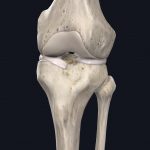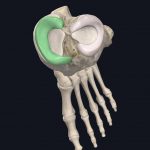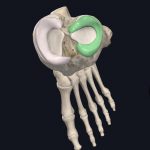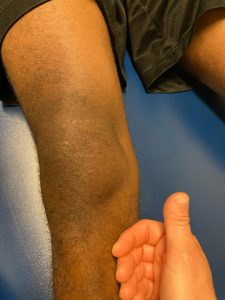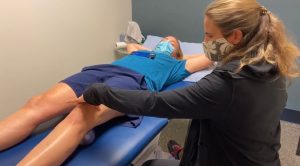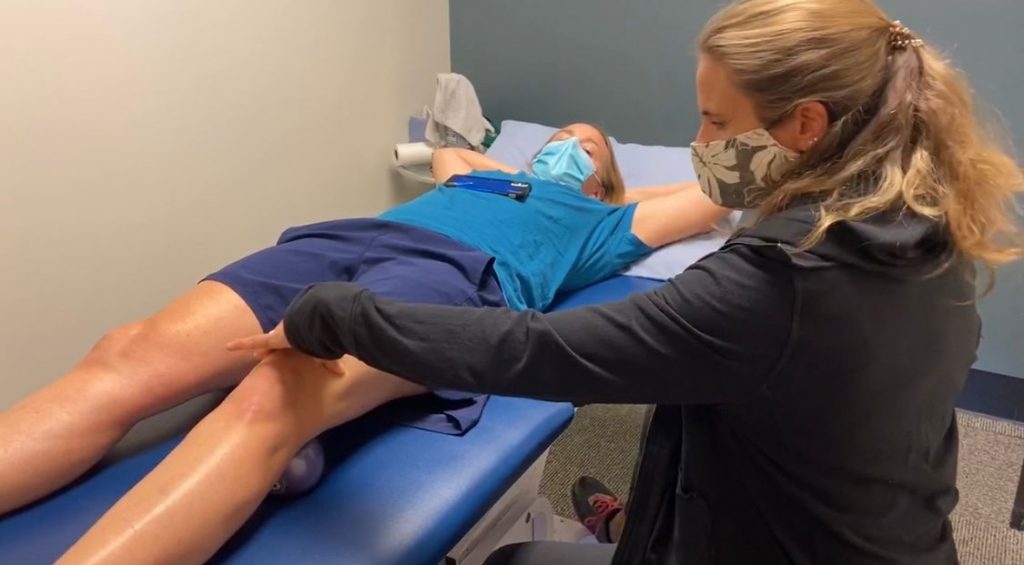
Your recovery after a meniscus surgery depends on your dedication to rehabilitation. Make sure you read up on the expectations after surgery to understand how to recover well without risking another injury.
If you’re looking for a physical therapy clinic on O’ahu, Hawaii after your surgery, check out JACO Rehab’s team! You’ll get the 1-on-1 attention you deserve for over 50 minutes. Each treatment is personalized to your needs. Reach out today.
The Mighty Menisci
You have two menisci in your knee: the medial and lateral meniscus. Both are circular cartilage structures in the knee joint. They have a flexible and fibrous structure, which serves as an excellent shock absorption system when walking, running, and jumping.
- Front View of Knee
- Medial Meniscus in Knee (highlighted)
- Lateral Meniscus in Knee (highlighted)
Images Courtesy of Complete Anatomy
Menisci also help the joint “fit” well by improving how the femur glides on the tibia when you bend or straighten your knee. They even have their own lubrication system which delivers nutrients to the joint. (1)
Read more about how meniscus injuries happen and what types of tears influence your outcome.
Types of Surgeries to Address Meniscus Tears
Your surgeon will likely choose one of two options to address your meniscus tear. His/her choice will depend on the severity of the tear, your age, and your goals.
Meniscectomy
During a meniscectomy, the surgeon will enter the knee arthroscopically to remove the torn part of the meniscus. It is minimally invasive and quick. However, your recovery will take time.
Meniscectomies are prone to swelling or “effusion” after surgery. This is because part of the meniscus is now removed, which impairs shock absorption. Physical therapy is important to monitor swelling during graded return to activity. The protective muscles of your knee will need to redevelop strength so that they can help offload the structures in the knee.
- Example of swelling in the knee
Meniscus Repair
A meniscus repair is more involved than a meniscectomy. This is also a minimally invasive surgery. However, a meniscus repair will not remove the damaged area. Instead, it repairs it by stitching the damaged cartilage back into place.
Because the surgery now involves a mending piece of cartilage, you will have more restrictions than a meniscectomy. These protocols are s-t-r-i-c-t for your protection. Make sure you understand and follow them fully!
It typically takes 6-8 weeks for a well-vascularized region of the meniscus to heal. That’s just the beginning.
During its healing time, your protocol will require a brace. You may also be required to use crutches to offload the knee partially or completely depending on the location of the tear.
You may also have restrictions on how far you can bend it for the first few weeks.
What gives with all these restrictions? They’re in place to protect the surgery. Breaking protocol can place you at risk for undoing stitching or delaying healing. You may even create a new injury.
Bottom line: honor your restrictions!
Preparing for Surgery
As you get ready for your surgery, don’t be afraid to ask questions specific to you and your circumstances. You will likely have a pre-op appointment with your surgeon, so write a list of things you want to know.
Consider asking your surgeon these questions to clarify your expectations:
- Which type of surgery am I receiving?
- What protocol will I follow after my surgery?
- When should I start physical therapy after surgery?
- Should I get anything before my surgery to help me in the first few days?
You can also ask your physical therapist some questions if you’ve been seeing one. If you haven’t consider making a prehab appointment before your surgery.
Ask your physical therapist these questions:
- How do I get in the car after surgery?
- How do I go up/down my stairs safely using crutches?
- What’s the safest way to get in/out of my bathtub?
- What should I do immediately after surgery to start recovering?
- How should I position myself when I’m resting or asleep?
It is very possible that your surgeon may change his course of action during the procedure. MRIs don’t always show the extent of an injury, so your injury may look different when the surgeon sees it. He/she may alter the surgery which could change the protocol.
During your post-op appointment with your surgeon, ask these questions:
- Did the surgery go as expected?
- Will I be following the same protocol as we discussed?
- Are there exercises you’d like me to do until I get to physical therapy?
- How do I care for my bandages?
Not only will this help you understand your surgery, but you’ll also understand your recovery process as you work closely with your physical therapist.
It will be a good idea to arrange for a friend or family member to be nearby for a few days after your surgery just in case you need assistance. Keep in mind that you won’t be able to drive for a while.
Recovery: What to Expect After Your Meniscus Surgery
It doesn’t matter what surgery you receive – the first few days are always rough. The medication, the swelling, the discomfort… it’s all part of the process.
Your surgeon will likely see you a few days after the surgery. He will discuss how it went, and you can bring up any questions that you may have. Make sure you clarify your protocol at this time.
You will also start physical therapy soon after your surgery, often within the first week or two depending on your surgeon’s approach.
Meniscectomies and meniscus repairs both have different timelines depending on the person. Everyone’s recovery process is different.
The best way you can control your timeline is by following your restrictions to protect the surgery. Swelling and pain dictate your ability to wean off your brace and crutches. By breaking protocol, swelling and pain will increase which delays your progress.
Full recovery for a meniscus surgery can take anywhere from 1.5-6 months depending on your circumstance. If you’re looking to return to sport, expect to start competing again closer to the 6-month mark. If your injury also involves other structures, it may take longer. In the meantime, you’ll be working on movement fundamentals and strengthening to get you fully prepare you for your sport without re-injury.
Make sure you get guidance through your recovery. You want a successful surgery!
Physical Therapy and Meniscus Surgeries
It’s okay to be nervous starting physical therapy after your surgery!
We would be lying if we didn’t admit that there’s some level of discomfort, especially during the first few sessions while we get your knee moving. We must prevent your knee from stiffening up, or else your road to recovery becomes very long.
Getting the knee straight is the main priority. The best way to keep it straight is by strengthening the quadriceps, which reinforces the extended knee position. It also gets you ready for full weightbearing when you’re ready.
- Getting the quads working!
Your knee will start to feel better as it regains flexibility and strength during its recovery time. As time passes and your restrictions are lifted, you’ll slowly add new exercises to your regimen that progress you towards your specific goals.
They usually involve:
- Full range of motion
- Normalized walking
- Squatting
- Stair climbing
- Pivoting
- Negotiating uneven ground, including dirt and sand
Goals can also involve jumping, running, and return to sport depending on your activity level prior to the injury.
Physical therapists will monitor your swelling levels as you progress. Over-doing activities can result in a spike in swelling, indicating that the knee is undergoing too much stress. If you notice spikes in swelling with activities at home, make sure you tell your physical therapist so you can problem solve the issue.
Does Meniscus Surgery Lead to Knee Replacement?
Once you’ve injured your knee’s cartilage, you are more vulnerable to further injury, especially without proper recovery and rehabilitation. But this doesn’t automatically mean you’ll need a knee replacement in the future.
Knee replacements are required if there’s significant cartilage degeneration in your knee to the point of pain and loss of function. If there’s evidence of continued knee injury later in life, and if you’re struggling to perform daily tasks due to knee pain and stiffness, that’s when you may consider a knee replacement. However, you’ll likely revisit physical therapy first before resorting to surgery.
Good Luck!
Now that you know what to expect after a meniscus surgery, you’re one step ahead!
Stay positive through the process – there’s a light at the end of the tunnel! Make sure you check out JACO Rehab and schedule your post-op appointments to avoid a delay in treatment. You’ve got this.
Cited References
1. Fox AJ, Bedi A, Rodeo SA. The basic science of human knee menisci: structure, composition, and function. Sports Health. 2012 Jul;4(4):340-51. doi: 10.1177/1941738111429419. PMID: 23016106; PMCID: PMC3435920.
2. Mordecai SC, Al-Hadithy N, Ware HE, Gupte CM. Treatment of meniscal tears: An evidence based approach. World J Orthop. 2014 Jul 18;5(3):233-41. doi: 10.5312/wjo.v5.i3.233. PMID: 25035825; PMCID: PMC4095015.
